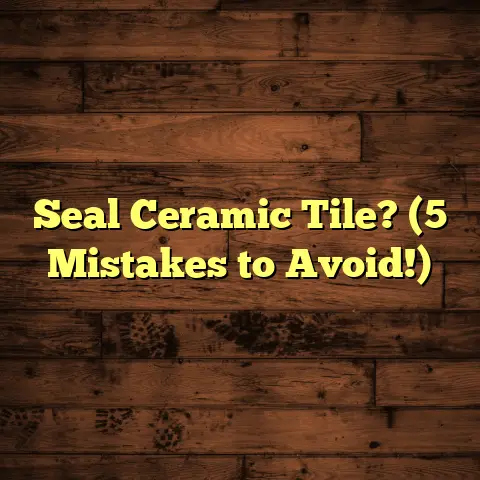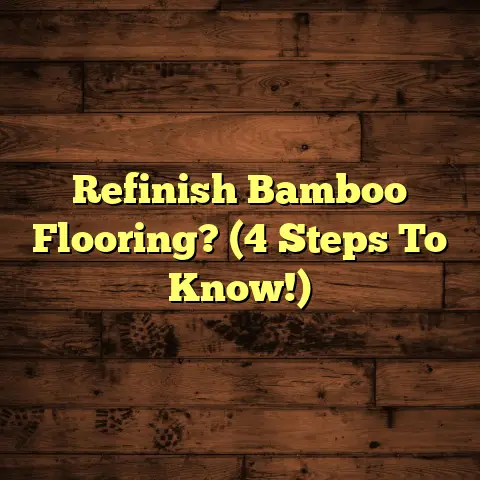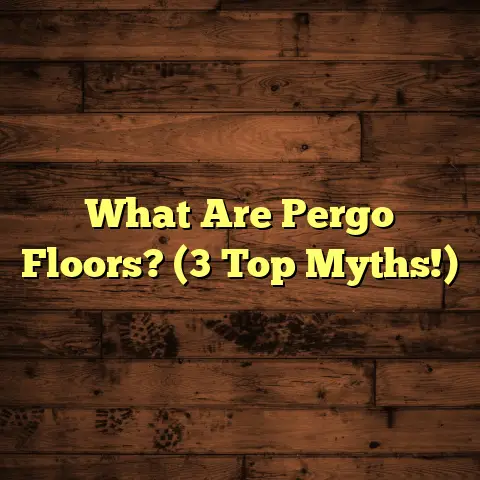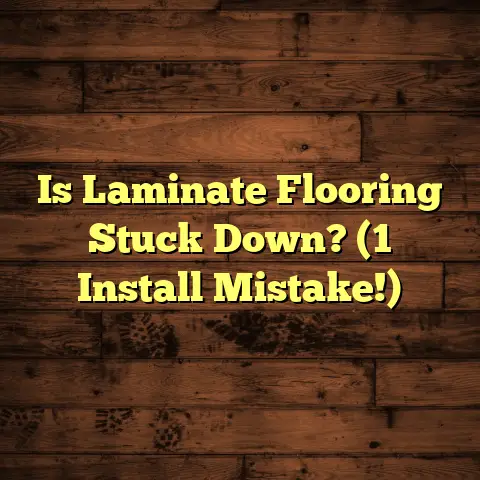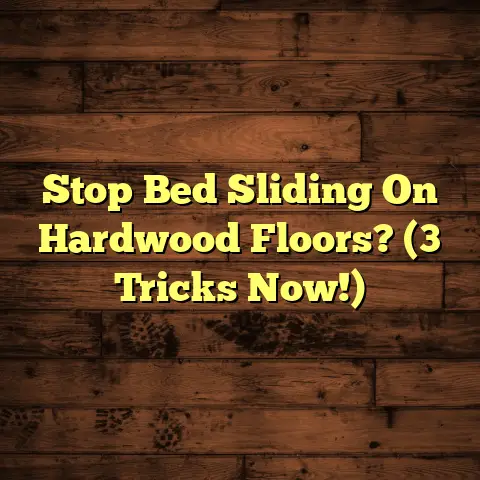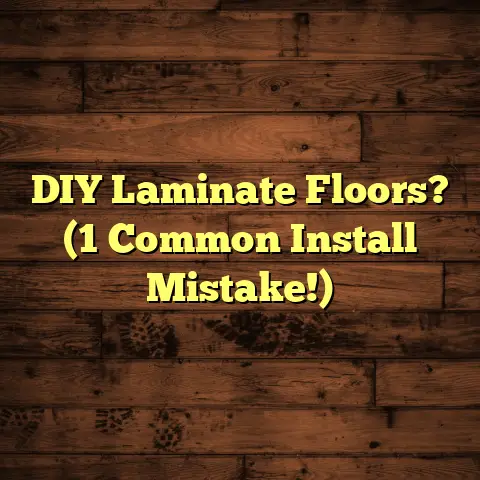Lay LVP On Concrete: How To? (6 Install Fails!)
I’m your friendly neighborhood flooring contractor, and I’m stoked to talk about one of my favorite flooring options: Luxury Vinyl Plank, or LVP.
LVP has exploded in popularity, and for good reason. It’s stylish, durable, and, best of all, it’s something you can totally tackle yourself.
Thinking about upgrading your space with LVP?
Awesome!
Laying LVP over concrete is a fantastic way to go.
It’s moisture-resistant, looks amazing, and, with the right know-how, it’s surprisingly easy to install.
But, and this is a big but, even the most seasoned DIYers can run into snags.
That’s why I’ve put together this guide.
I’m going to walk you through the entire process, from prep to finish, and I’m going to call out the six most common installation fails that I see time and time again.
My goal? To give you the confidence and knowledge you need to nail your LVP installation and create a space you’ll love for years to come.
Let’s get started!
Section 1: Understanding LVP and Concrete Subfloors
So, what exactly is Luxury Vinyl Plank?
Think of it as the cool, younger sibling of traditional vinyl flooring.
It’s made of multiple layers, usually including a wear layer (the top layer that protects against scratches and dents), a decorative layer (that’s where you get the wood-look or tile-look), and a core layer (which provides stability and water resistance).
Compared to older vinyl, LVP is thicker, more durable, and just plain looks better.
Why LVP is awesome:
- Water resistance: Perfect for kitchens, bathrooms, and basements.
- Durability: Can handle heavy foot traffic and everyday wear and tear.
- Style: Comes in a huge range of colors, patterns, and textures.
- DIY-friendly: Most LVP is designed for easy click-lock installation.
Now, let’s talk about concrete.
As a subfloor, concrete is like a blank canvas.
It’s strong, stable, and provides a solid base for your LVP.
But, it’s not without its quirks.
Concrete’s pros:
- Strength: Can support heavy furniture and appliances.
- Stability: Provides a flat, even surface for your flooring.
- Longevity: Concrete floors can last for decades.
Concrete’s cons:
- Moisture: Concrete is porous and can absorb moisture from the ground.
- Cracks: Over time, concrete can develop cracks due to settling or temperature changes.
- Unevenness: Concrete floors can be uneven, especially in older homes.
- Cold: Concrete can feel cold underfoot, especially in the winter.
So, why is LVP a good match for concrete?
Well, LVP is flexible enough to handle minor imperfections in the concrete surface.
It’s also water-resistant, which is crucial because concrete can wick moisture.
Plus, it’s relatively easy to install over concrete, especially if you choose a click-lock LVP.
Types of LVP:
- Click-lock: These planks have interlocking edges that snap together, making installation a breeze. This is my go-to for DIY projects.
- Glue-down: These planks are glued directly to the concrete subfloor. This method requires more skill and precision, but it can provide a more permanent and stable installation.
Which type should you choose?
For most DIYers, I recommend click-lock LVP. It’s forgiving, easy to work with, and requires minimal tools.
However, if you’re dealing with a very uneven or damaged concrete floor, glue-down LVP might be a better option, but be prepared for a more challenging installation.
Section 2: Preparing for Installation
Alright, you’ve got your LVP, you’ve got your concrete subfloor, now it’s time to get down to business!
Proper preparation is the most important step in any flooring project.
Trust me, I’ve seen too many beautiful floors ruined by skimping on the prep work.
Here’s what you need to do:
1. Cleaning the Concrete Floor:
This is non-negotiable.
You need to remove all dust, debris, old adhesive, and anything else that might prevent the LVP from adhering properly.
I recommend starting with a good sweep, followed by a thorough vacuuming.
For stubborn dirt or adhesive, use a scraper and a concrete cleaner.
Pro Tip: Rent a concrete grinder with a vacuum attachment for heavily soiled floors. It’ll save you a ton of time and effort.
2. Moisture Testing:
Moisture is the enemy of LVP.
If your concrete floor is too damp, the LVP can warp, buckle, or even develop mold.
You must test the moisture level before you start installing.
Here are a few ways to do it:
-
Calcium Chloride Test: This is the most accurate method, but it requires renting a kit and following the instructions carefully. The test measures the amount of moisture vapor emitting from the concrete over a 72-hour period.
- Acceptable levels generally are less than 3 lbs per 1000 square feet over 24 hours.
-
Plastic Sheet Test: Tape a 2’x2′ piece of clear plastic sheeting to the concrete floor and leave it for 24-48 hours. If you see condensation under the plastic, your floor is too damp.
-
Moisture Meter: A handheld moisture meter can give you a quick reading of the moisture level in the concrete.
- Target moisture levels should be below 4.5%.
What to do if your floor is too damp:
- Dehumidify: Run a dehumidifier in the room to lower the humidity level.
- Moisture Barrier: Apply a moisture barrier to the concrete floor before installing the LVP.
- Wait: Sometimes, you just need to wait for the concrete to dry out naturally.
3. Repairing Cracks and Leveling Uneven Surfaces:
Even small cracks or unevenness can cause problems with your LVP installation.
Cracks can telegraph through the LVP, creating unsightly lines.
Unevenness can cause the LVP to flex and eventually break.
Here’s how to fix it:
- Cracks: Use a concrete crack filler to fill in any cracks. Follow the manufacturer’s instructions carefully.
- Uneven Surfaces: Use a self-leveling compound to create a smooth, level surface. This is especially important if you have significant dips or humps in your concrete floor.
4. Acclimating the LVP Planks:
This is another crucial step that many DIYers skip.
LVP planks need to acclimate to the temperature and humidity of the room before you install them.
This allows the planks to expand or contract to their natural size, preventing warping or buckling after installation.
How to acclimate LVP:
- Bring the LVP planks into the room where you’ll be installing them at least 48-72 hours before you start.
- Remove the planks from their packaging and spread them out in the room.
- Maintain a consistent temperature and humidity level in the room.
Pro Tip: Check the manufacturer’s instructions for specific acclimation recommendations.
Section 3: Installation Techniques
Okay, the moment you’ve been waiting for!
Let’s get those LVP planks on the floor.
I’m going to walk you through the process step-by-step, assuming you’re using click-lock LVP.
1. Choosing and Installing Underlayment (If Applicable):
Some LVP comes with a pre-attached underlayment.
If yours doesn’t, you’ll need to install a separate underlayment.
Underlayment provides cushioning, sound insulation, and moisture protection.
It’s worth the investment, especially if you have a cold or noisy concrete floor.
How to install underlayment:
- Roll out the underlayment over the concrete floor.
- Cut the underlayment to fit the room, leaving a small gap around the edges.
- Tape the seams together with underlayment tape.
2. Laying Out the Planks and Planning the Layout:
Before you start clicking planks together, it’s a good idea to plan your layout.
This will help you minimize waste and ensure that your floor looks its best.
Here’s how to do it:
- Measure the length and width of the room.
- Determine the direction you want to lay the planks.
- Calculate how many rows of planks you’ll need.
- Consider staggering the planks to create a more natural look.
- Pay attention to doorways and other obstacles.
Pro Tip: Start with a full plank in the most visible area of the room. This will help you avoid ending up with small, awkward pieces in prominent locations.
3. Installing the LVP Planks:
Now for the fun part!
Here’s how to install click-lock LVP:
- Start in one corner of the room.
- Place the first plank with the tongue side facing the wall.
- Click the second plank into the first plank at a slight angle.
- Continue clicking planks together, working your way across the room.
- Use a tapping block and a hammer to gently tap the planks together for a tight fit.
- When you reach a wall or other obstacle, measure and cut the plank to fit.
- Use a utility knife or a saw to cut the planks.
- Leave a small expansion gap around the perimeter of the room.
4. Addressing Challenges During Installation:
No matter how well you plan, you’re bound to encounter some challenges during installation.
Here are a few common problems and how to solve them:
- Planks won’t click together: Make sure the planks are properly aligned and that there’s no debris in the groove.
- Planks are difficult to cut: Use a sharp blade and apply firm, even pressure.
- Gaps between planks: Use a tapping block and a hammer to gently tap the planks together.
Pro Tip: Don’t be afraid to experiment! If you’re not happy with the way something looks, you can always take it apart and try again.
Section 4: Common Installation Fails
Okay, let’s talk about the elephant in the room: mistakes.
Even seasoned DIYers can mess up an LVP installation, especially when working with concrete.
I’ve seen it all, from warped planks to buckled floors.
That’s why I want to share the six most common installation fails that I see.
By knowing what to look out for, you can avoid making these mistakes yourself.
1. Improper Moisture Management:
The Fail: Ignoring moisture levels and skipping moisture testing.
The Consequences: Warped planks, mold growth, and a ruined floor.
How to Avoid It: Test the moisture level of your concrete floor before you start installing.
Use a calcium chloride test, a plastic sheet test, or a moisture meter.
If the moisture level is too high, take steps to dry out the floor before you proceed.
2. Insufficient Surface Preparation:
The Fail: Skipping cleaning and repair steps.
The Consequences: Poor adhesion, uneven floor, and premature wear and tear.
How to Avoid It: Thoroughly clean the concrete floor, removing all dust, debris, and old adhesive.
Repair any cracks or unevenness with a concrete crack filler or a self-leveling compound.
3. Incorrect Plank Orientation:
The Fail: Laying the planks in the wrong direction.
The Consequences: A visually unappealing floor and a sense of disharmony in the room.
How to Avoid It: Consider the shape and size of the room when choosing the plank orientation.
In general, running the planks parallel to the longest wall will make the room look larger.
4. Failure to Acclimate:
The Fail: Not allowing the LVP planks to acclimate to the room’s temperature and humidity.
The Consequences: Warped planks, gaps between planks, and a buckled floor.
How to Avoid It: Bring the LVP planks into the room where you’ll be installing them at least 48-72 hours before you start.
Remove the planks from their packaging and spread them out in the room.
Maintain a consistent temperature and humidity level in the room.
5. Skipping Underlayment:
The Fail: Not using an underlayment, especially on a concrete floor.
The Consequences: Noise issues, discomfort underfoot, and potential moisture problems.
How to Avoid It: Choose an underlayment that is specifically designed for use with LVP and concrete.
Make sure the underlayment is thick enough to provide adequate cushioning and sound insulation.
6. Poor Cutting Techniques:
The Fail: Making inaccurate or sloppy cuts.
The Consequences: Gaps between planks, wasted material, and a unprofessional-looking floor.
How to Avoid It: Use a sharp blade and apply firm, even pressure when cutting the planks.
Use a square to ensure that your cuts are straight.
Practice cutting on scrap pieces before you start cutting the actual planks.
Section 5: Maintenance and Care
You’ve installed your LVP floor, and it looks amazing!
Now, it’s time to talk about maintenance and care.
With proper care, your LVP floor can last for many years.
Here are some tips:
- Regular Cleaning: Sweep or vacuum your LVP floor regularly to remove dust and debris.
- Damp Mopping: Mop your LVP floor with a damp mop and a mild detergent. Avoid using harsh chemicals or abrasive cleaners.
- Avoid Excessive Water: Wipe up spills immediately to prevent water from seeping into the seams.
- Use Floor Protectors: Place floor protectors under furniture legs to prevent scratches and dents.
- Avoid Direct Sunlight: Prolonged exposure to direct sunlight can cause the LVP to fade. Use curtains or blinds to protect your floor.
- Repairing Damaged Planks: If a plank gets damaged, you can usually replace it. Use a utility knife to cut around the damaged plank and remove it. Then, install a new plank in its place.
Recommended Cleaning Products:
- Bona Stone, Tile & Laminate Floor Cleaner
- Armstrong Flooring Once ‘n Done Floor Cleaner
- Black Diamond Stoneworks Stone & Tile Floor Cleaner
Cleaning Frequency:
- Sweep/Vacuum: Daily or as needed
- Damp Mop: Weekly or bi-weekly
Conclusion
Wow, we covered a lot!
From understanding LVP and concrete to avoiding common installation fails, you’re now armed with the knowledge you need to tackle your LVP flooring project with confidence.
Remember, LVP is a fantastic flooring choice that’s both stylish and DIY-friendly.
Don’t be afraid to get your hands dirty and create a space you’ll love.
And, if you run into any problems, don’t hesitate to reach out to a professional.
But, with the tips and tricks I’ve shared, I’m confident that you can create a beautiful, durable LVP floor that will last for years to come.
So, go ahead, grab your LVP, gather your tools, and get ready to transform your space!
I’m cheering you on every step of the way.
Happy flooring!
